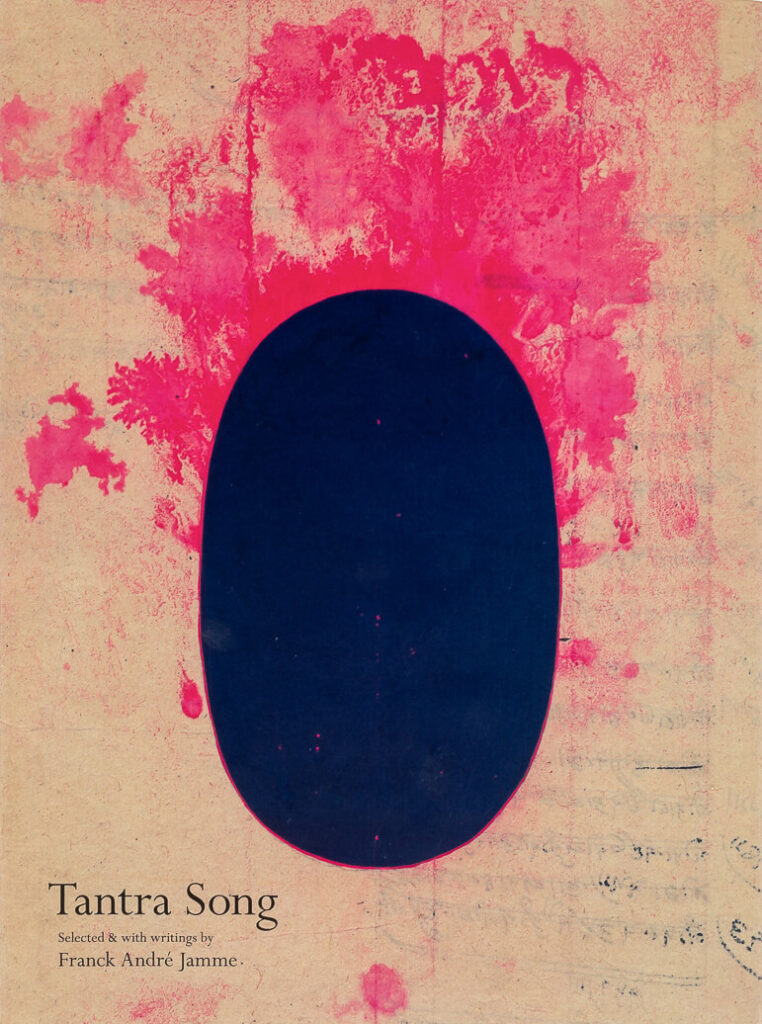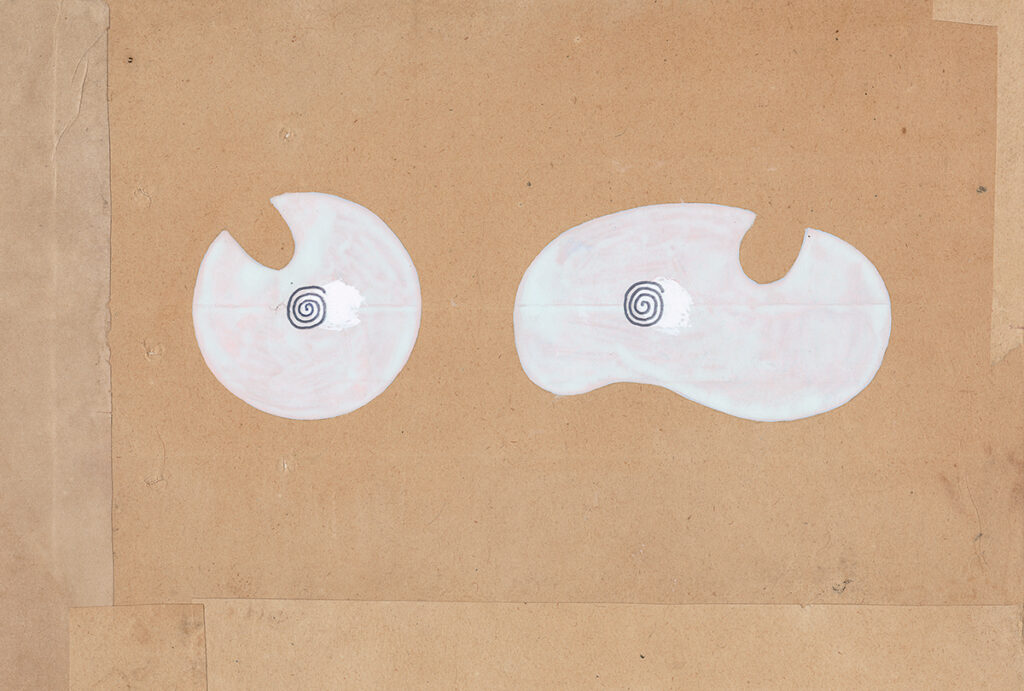A Silver Lining To All That DarknessBill Berkson interviews Franck André Jamme
excerpts, 09/25/11
Excerpt from Tantra Song: Tantric Painting from Rajasthan, edited by Franck André Jamme. All rights reserved. © 2011 Bill Berkson, the Estate of Franck André Jamme and Siglio Press. All rights reserved.
Bill Berkson
How did you first discover this type of Tantric art?
Franck André Jamme
Well, very first in a small catalogue from an exhibition held in 1970 at Le Point Cardinal Gallery in Paris. At a bookseller’s stall, a few years later, the names of Henri Michaux and Octavio Paz (who had supplied a poem and a short essay, respectively, to the thin volume) drew me like a magnet. There were also some books by Ajit Mookerjee. All that I found in Paris. Then, later, in 1982, I went to Nepal and on the road I actually stopped for a short week in India, hoping I could see and perhaps find some of these abstract Tantric paintings. I saw the “Mookerjee Room” in the National Museum of Art in Delhi but I couldn’t find any pieces. In fact I just wanted to go to Nepal because I was very interested in Tibetan people, loved Milarepa and Drukpa Kunley [a major author of medieval Himalayan culture, from Bhutan]. Frankly, I was not interested in this particular school of Buddhism, but rather in the physical and cultural similarities between the Tibetans and North American Indians, for example their folk dances, shamanic practices and even the fact that some Tibetan men actually look like Geronimo or Cochise. It was just before I helped René Char edit his complete works. In fact René offered me this trip. He was also a Milarepa fan and he loved the idea of going to see the Tibetan people. At that time, entry to Tibet was forbidden and the only way was to go to Nepal where there were very big camps of Tibetan refugees around Katmandu. René even wanted to come with us—I was married then—but, well, he was just joking.
BB
This was the first of many trips to India for you …
FAJ
Yes, so many, more than fifteen now. I made my next trip in 1984. Char’s complete works were finished. I stopped for something like two long weeks in India. I seriously tried to find some abstract Tantric paintings. I asked everywhere I could, but in vain. After these two first voyages to India, I decided in 1985 to dedicate a new trip—this time, just in Rajasthan—exclusively to search for these pieces. I was very curious about them; they were so close to our modern or even contemporary art, from Malevich and Paul Klee to Agnes Martin and Daniel Buren, and many others. It was strange that such modern, occidental-looking patterns already existed in India during the 17th century, and they were so simple, so powerful, so quietly and naturally abstract, so near, as well, to my own field, which was already something like poetry. Poetry is so often like that, isn’t it? Playing with words, using words in such a natural abstract way.
So I arrived in Delhi, spent four or five days there, and found myself one morning in front of a bus for Jaipur. I immediately felt the bus was not the right one, but I was with my wife and quite a lot of luggage and stress, so reluctantly I decided to board this bus. On the road, thirty kilometers after leaving Delhi, first the driver ran into a small farmer’s cart. He argued half an hour with the peasant, finally gave him some bills, and we started off again. By then, the driver was looking really tired; perhaps he had driven his “deluxe” bus for some days without really resting, I don’t know. I had chosen a seat in the front row (I wanted to shoot some photos on the road, quietly). Another thirty kilometers later, suddenly I saw a big truck coming from the opposite direction and heading straight toward our bus. After that, I have just bits and pieces of memory. I experienced several comas. Later I learned that I had been brought in another bus—because I had a ticket for Jaipur, I had to go to Jaipur — to the Jaipur General Hospital with nine fractures, and also that seven people around me on the bus had died. I spent two days in this hospital without any special first aid. I remember hearing that the hospital didn’t have any anesthetic. Then my wife called the French embassy in Delhi. They sent somebody who put me on one plane Jaipur-Delhi, then another Delhi-Paris, in a sort of hammock. I spent three weeks in a Parisian hospital, then six months at home in a hospital bed. In this bed I wrote the book called The Recitation of Forgetting (1) that John Ashbery translated almost twenty years later.
BB
A silver lining to all that darkness …
FAJ
Yes — fortunately. But there followed two bad years, not just for my broken body but also for my mind. It was really too difficult to live with the memory of this failure. Like when you have fallen off your horse, the best is to get up and ride again as soon as possible. After many discussions with friends, especially a doctor, I decided to go back to India. I went to a friend in Udaipur. I spoke with him a lot, and he told me that perhaps it would be a good idea to go and see an astrologer and soothsayer whom his family had known for a long time. I went and saw this strange man. He just asked me my astrological coordinates and what I wanted to know. I replied that I just wanted to know if I could try to continue my research on these abstract Tantric paintings. He told me to come back in two days time. When I came back, there was something new in the room, a very big bowl full of sand. He asked me to wash my hands in this sand, and he then read the sand during, you know, fifteen minutes, which seemed to me an eternity. Then he told me something like, “In fact, you are a lucky boy.” Here, I’m afraid, I smiled. “You have paid your tribute to the goddess. You can carry on now with your research. You can find some of these paintings, you can discover what they mean, you can show them abroad, you can even sell them. But after what has already happened, we must be very prudent. If you really want to continue your research, okay, but you will have to follow very strictly two rules. First, when you go and visit a tantrika family, you must go only alone or with someone you love—to be clear, for example, not with your best friend or your sister or your new girlfriend. The second caution is regarding the possibility of showing and selling the pieces. You can show and sell them, okay—but for just enough to make your living.” Then he added, “With these conditions you could be of great help to this small, wonderful art, in which so few people in India take an interest.”
Well, that was the end of the meeting. As he walked me back to the door, I thought in quick succession how amazing this gentleman really was, but what could I do with his advice, where would I find the tantrika families? When we arrived on the doorstep, he looked at me, smiled—like a fox, he really had a fox-like face, by the way—and told me, “Well, I think I forgot to give you something.” He asked a young servant who was near to go and fetch a pen and paper. The servant went and came back, and the soothsayer wrote out my two first addresses of tantrika nests. Well, strangely, everything began from that moment. Later, I returned to India, went and visited these first families, who then sent me to another branch of the family or to another family entirely. Pretty much all over Rajasthan. The work was then on course. Afterwards it took, let’s say, ten years to begin to know something, even if only a tiny something, about this amazing art. Especially, to find over the years, by trawling among the statements of numerous tantrikas, the precise meaning of each scheme, each image.
BB
What makes this art so amazing?
FAJ
Well, I think its main particularity is that it is first of all a practice. First for the “artist” himself when he paints a piece, and then for the people who are later going to work on seeing this image, to meditate on it and its meaning—and what is more, through this meditation, finally to make the divinity herself appear. I don’t know if there are many other arts that have those qualities. And, on the other hand, this has not killed the aesthetics, the grace of these things. Tantrism is too free, too open for one not to see, to accept, to appreciate, even to revere the beauty of these paintings. They are now collected also in the western world, but in India that has certainly been true for centuries.
see also
Books
Tantra SongTantric Painting from RajasthanTranslated by Michael Tweed, introduction by Lawrence Rinder, interview by Bill Berkson and essay by André Padoux

Excerpts
How a symbol of god comes alive next to a smudge or smearIntroduction to Tantra Song: Tantric Painting from RajasthanLawrence Rinder

✼ elsewhere:
“Not an object or a text but a name, a spirit: Jean Brown … The name ‘Jean Brown’ itself was, for me, the conduit of Howe’s “mystic, documentary telepathy.” When her name appeared on a citation, I sensed that this object or book had been carefully selected, cared for, considered, held.”
[...]